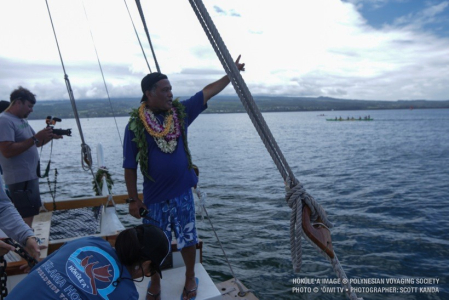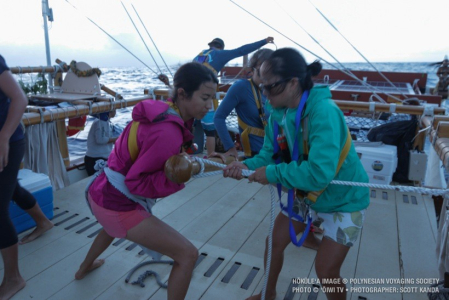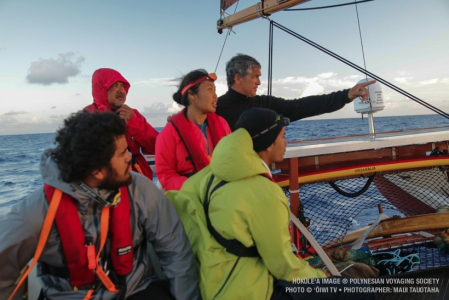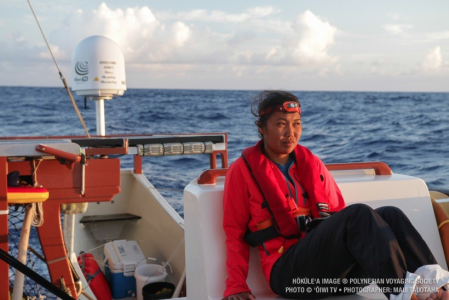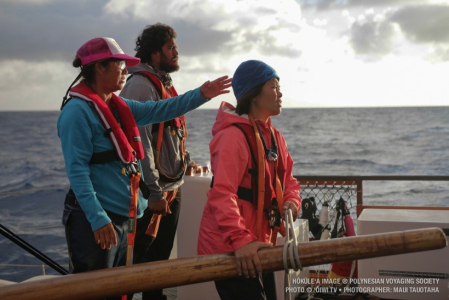Hoʻāno Ana i Nā Kūpuna o Mua: Honoring the Ancestors Who Went Before Us
- Posted on 1 Jun 2014
- In Crew Blogs, Cultural, ʻŌlelo Hawaiʻi, Voyaging
E ka poʻe i aloha i ka ʻāina, welina mai me ke aloha. Eia nō mākou ke holo kaulua nei ma kekahi o nā waʻa hanohano o Oʻahu a Lua lā, ʻo Hōkūleʻa lāua ʻo Hikianalia. Ua haʻalele aku nei nō mākou i ka ua Kanilehua o Hawaiʻi nui kuauli no ka holo ʻana aku i Laniloa, ʻo ia hoʻi o Rangiroa, ma ka huina moku o nā Tuamotu, a noke ana i ka holo a pae aku i Papeʻete ma Tahiti, kahi i pae ai ʻo Hōkūleʻa ma ka huakaʻi mua i ka makahiki 1976.
Holo akula wau i ʻekolu huakaʻi lōʻihi ma mua o kēia huakaʻi. Mai Hawaiʻi a i Maikonekia, mai Palmyra a i Hawaiʻi, a mai Aotearoa nō hoʻi a i Tahiti. Ua wela kekahi, ua anuanu kekahi, ua koʻekoʻe kekahi, a ua maikaʻi ka holo ʻana o nā mea pau. ʻO kēia huakaʻi naʻe ka mea kū nō i ka hoihoi oʻu. ʻOiai e holo ana mākou ma ke kaulua e like me ko nā kūpuna holo ʻana, e nānā wale ana nō i nā ʻale like o ka moana i ʻike ʻia e nā kūpuna, e kilohi ana i nā hōkū like, e pā ana i ka makani like, e nānā like ana i ka holo ʻana o ke keiki kapu a Wākea (‘o ia hoi ‘o ka lā), a ‘o ka mea nui e ‘okoʻa ai kēia huakaʻi, a ‘okoʻa nō hoʻi ai nā mea o mua, ke holo nei mākou ma ke alahula o nā kūpuna o mua o mākou, ka moana hoʻi ma waena o Hawaiʻi me Tahiti. ‘O kēia ke ono o ka huakaʻi o Hōkūleʻa mai Hawaiʻi aku a i Tahiti. He mea nui ia. Eia naʻe, ʻaʻohe poina ʻana i nā inoa o nā kūpuna kekahi, ‘o Papa, ‘o Kaʻulu, ‘o Hema, ‘o Kahaʻiahema, o Paumakua, ‘o Mōʻīkeha lāua ‘o ‘Olopana, a pēlā aku.
‘O kekahi kumu hoʻi i kū ai kēia huakaʻi i ka hoihoi, ke holo nei mākou mai ke kai a Kāne, holo ana i ka piko o Wākea, a noke ana i ke kai a Kanaloa. Iā mākou ma ka moku o Keawe, kipa akula kekahi o mākou i ka piko o Wākea ma ka mauna a Wākea. Iā mākou e holokai ana, e kipa hou ana i ka piko o Wākea ma ka moana, a e hoʻokupu ʻia ana ka wai mai ka mauna a Wākea mai a i ka moana a Wākea ala, i ka wā hoʻi a Wākea (ka wā e kū ai ka lā i ka lolo, ʻo ia hoʻi ke a-wakea). No laila, e kū ana ka waʻa i kahi manamana nui a Wākea, ma waena o ke alanui polohiwa a Kāne ma ka ‘Ākau, a me ke alanui polohiwa a Kanaloa ma ka Hema, ke ala ‘ula a Kāne ma ka Hikina, a me ke alanui maʻawe ʻula a Kanaloa ma ke Komohana. He mea nui ana ia no mākou. A he mea nui nō hoʻi no kākou ka hoʻomaopopo ʻia ʻana o nā akua, nā ʻaumākua, a me nā kūpuna o kākou. Ma o ke ola mau ʻana o nā iwi o nā kūpuna, pēlā nō kākou e ola mau ai.
To all of you who love our Hawai’i, greetings of aloha. Here we are sailing on two esteemed double-hulled canoes from the island of Oʻahu (referred to as “Oʻahu child of Lua”) – Hōkūleʻa and Hikianalia. We have left the Kanilehua rains of verdant Hawaiʻi island headed for Rangiroa in the Tuamotu islands, and from there we will forge ahead to Papeʻete in Tahiti, the same place where Hōkūleʻa first made landfall back in 1976.
I have been on three long voyages prior to this: from Hawaiʻi to Micronesia, Palmyra to Hawaiʻi, and Aotearoa to Tahiti. Some were hot, some cold, some wet and damp, but all of them were amazing journeys. This particular voyage however is one that I am truly passionate about. We will sail on double-hulled vessels as our ancestors did, watch the same swells as our ancestors, study the same stars, be embraced by the same winds, watch the same sun, and most importantly as with all journeys prior to this, we are travelling on the very same path as our ancestors did before us, on the ocean pathway from Hawaiʻi to Tahiti. This will be Hōkūleʻa’s sixth trip to Tahiti and it will be another great accomplishment for all of us on these waʻa today. But we do so remembering our ancestors who set the course for us long ago: Papa, Kaʻulu, Hema, Kahaʻiahema, Paumakua, Mōʻīkeha and ʻOlopana, and the like.
-Kaleo
________________________________________________________________________________________________________
[ii]Term used for several celestial references: Southern Sky, Winter Solstice, Tropic of Capricorn
[iii]Term used for several celestial references: Eastern Sky, Spring Equinox
[iv]Term used for several celestial references: Western Sky, Autumn Equinox
No nā kūmole a ʻikepili no ka Huakaʻi Holo Puni Honua, ʻo Mālama Honua, ma ka ʻōlelo Hawaiʻi!


